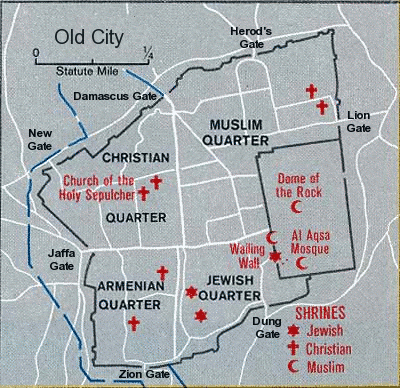Israeli Tourist Map of Jerusalem Rewrites History. Removes Palestinian Culture from the Map

The Israeli Ministry of Tourism is removing Palestinian culture from the map, in the most literal sense.
Last month, a new English-language guide to Jerusalem’s Old City was published, featuring fifty-seven tourist sites. Among them, only one was Muslim, five were Christian, while a whopping fifty-one were Jewish. Distributed for free at tourist offices, the map undermines Palestinian political claims to Jerusalem through a deliberate cultural whitewash that re-imagines the historically multi-ethnic and multi-religious city as exclusively Jewish.
According to a report from Haaretz, the map refers to the Dome of the Rock, the one Islamic site it mentions, by the Israeli, Hebrew terms of Temple Mount, Har Habait, and Mount Moriah. More alarmingly, the Al-Aqsa Mosque, the third holiest site in Islam and an important symbol of Palestinian nationalism, is labeled Solomon’s Stables.
These are paltry and distorted offerings, given the nearly 1,000 years of Islamic rule over Jerusalem.
Among the news map’s many omitted Christian sites is the Lutheran Church of the Redeemer, whose bell tower is one of the most recognizable features of the Old City’s skyline. The fourteen stations along the infamous Via Dolorosa – the path Jesus walked before his crucifixion – are also unlisted, even though they are a major tourist attraction.
Similarly, St Anne’s Church, built around 1138 and a striking example of medieval architecture, is not featured. The church, which is a testament to the city’s layers of religious heritage, was converted into an Islamic school after Saladin conquered the city in the 12th century before again becoming a church during Ottoman rule. This amalgamated history is marked by an Arabic-language plaque above the church’s front door.
Ignoring these centuries of diversity, the map lists a number of Jewish sites that are either of no interest to foreign visitors or that have a decidedly political (rather than religious) meaning. This includes multiple Jewish settler homes in the Muslim Quarter, which were appropriated from their Palestinian inhabitants with the help of Ateret Cohanim – a group that works to create a Jewish majority in the Old City. It also includes various illegal Israeli settlements, such as Maale ha-Zeitim and Beit Orot in the Mount of Olives, that have no meaningful religious significance.
Meanwhile, the Palestinian neighborhoods of Ras al-Amud and al-Tur have been altogether excluded from the map, and replaced with green fields. This erasure of East Jerusalem’s Palestinian inhabitants, who make up 40% of Jerusalem’s population, and a large majority in the Old City, is further reflected in the font sizes used to mark various landmarks.According to Haaretz, larger fonts have been used to mark the Jewish Quarter while smaller ones have been used for the Christian, Muslim, and Armenian Quarters.
The Israeli Ministry of Tourism has defended the map and rejected calls to revise its content, saying it serves as an “excellent” guide for international tourists. This erasure of 2,000 years of non-Jewish history is, however, little more than a thinly veiled attempt to bolster Israeli sovereignty over East Jerusalem, in an on-going battle of narratives over the city’s identity.



